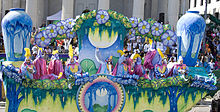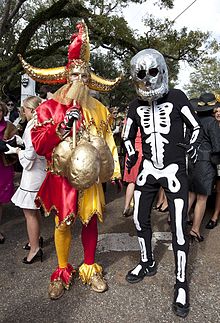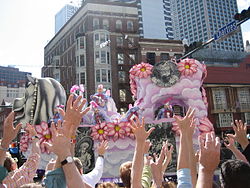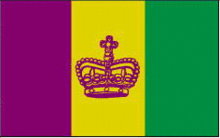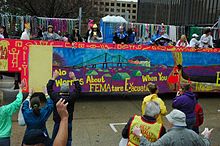- Mardi Gras in the United States
-
See also: Mardi Gras
While Mardi Gras in the United States is not observed nationally across the country, a number of cities and regions in the U.S. have notable Carnival celebrations. Because of the French and Spanish colonial history of the settlements, the earliest Carnival celebrations occurred in Mobile, Biloxi, New Orleans, and Pensacola, which have each developed separate traditions. In addition, modern activities generally vary from city to city across the U.S.
For Mardi Gras dates through 2050 see Mardi Gras Dates.
Contents
Early days in American colonies
Mardi Gras arrived in North America as a sedate French Catholic tradition with the Le Moyne brothers,[1] Pierre Le Moyne d'Iberville and Jean-Baptiste Le Moyne de Bienville, in the late 17th century, when King Louis XIV sent the pair to defend France's claim on the territory of Louisiane, which included what are now the U.S. states of Alabama, Mississippi, and Louisiana.[1]
The expedition, led by Iberville, entered the mouth of the Mississippi River on the evening of March 2, 1699, Lundi Gras, not yet knowing it was the river explored and claimed for France by René-Robert Cavelier, Sieur de La Salle in 1683. The party proceeded upstream to a place on the west bank about 60 miles downriver from where New Orleans is today, where a small tributary emptied into the great river, and made camp. This was on March 3, 1699, Mardi Gras day, so in honor of this holiday, Iberville named the spot Point du Mardi Gras (French: "Mardi Gras Point") and called the small tributary Bayou Mardi Gras.[2] Bienville went on to found Mobile, Alabama in 1702 as the first capital of French Louisiana.[3] In 1703 French settlers in that city began to celebrate the Mardi Gras tradition.[1][4][5] By 1720, Biloxi was made capital of Louisiana. While it had French settlers, Mardi Gras and other customs were celebrated with more fanfare given its new status.[1] In 1723, the capital of French Louisiana was moved to New Orleans, founded in 1718.[3] With the growth of New Orleans as a city and the creolization of different cultures, the varied celebration of Mardi Gras became the event most strongly associated with the city.[1] In more recent times, several U.S. cities without a French Catholic heritage have instituted the celebration of Mardi Gras, which sometimes emerged as grassroots movements.
Alabama
Mobile
Main article: Mardi Gras in MobileMobile is known for having the oldest organized Carnival celebrations in the United States, dating to the 18th century of its early colonial period. It was also host to the first formally organized Carnival mystic society or "krewe" in the United States, dating to 1830.[13] People from Mobile are known as Mobilians.[9]
Mobile's Carnival and Mardi Gras celebrations revolve around mystic societies, private social organizations that have been a fundamental part of the social and business fabric of the city. The mystic societies are organizations, similar to krewes in New Orleans, that present parades, masked balls, and activities for the enjoyment of its members, guests, and the public.[6] Mystic society membership is secret.[6] The mystic societies build colorful Carnival floats and parade throughout downtown Mobile during the Carnival season with masked society members tossing small gifts, known as "throws", to the parade spectators.[7] Throws may be trinkets, candy, cookies, peanuts, women's panties, artificial roses, stuffed animals, doubloons, cups, hats, can coolers, Frisbees, medallion necklaces, bead necklaces of every variety, and Moon Pies.[6]
Mobile's mystic societies give formal masquerade balls, known as bal masqués, which are almost always invitation only and are oriented to adults.[6] Attendance at a ball requires that a strict dresscode, or costume de rigueur, be followed. The formal dresscode usually involves full-length evening gowns for women and white tie with tails for male invited guests, and masked costumes for society members.[6] The balls feature dramatic entertainment, music, dancing, food, and drinks.[6] Balls are usually based upon a theme which is carried out through scenery, decorations, costumes, and a tableau vivant.[6]
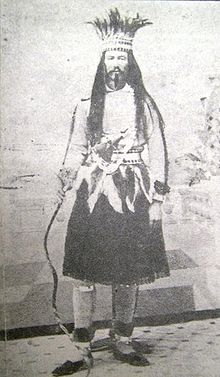 Joe Cain costumed as Chief Slacabamorinico.
Joe Cain costumed as Chief Slacabamorinico.
Mobile first celebrated Carnival in 1703 when French settlers began the festivities at the Old Mobile Site.[8] Mobile's first Carnival society was organized in 1704, when Nicholas Langlois founded Société de Saint Louis.[9] In 1711 it was renamed the Boeuf Gras Society (Fatted Ox Society) (1711–1861).[10] In 1830 Mobile's "Cowbellion de Rakin Society"' was the first formally organized and masked mystic society in the United States to celebrate with a parade.[8][11] The Cowbellions got their start when Michael Krafft, a cotton factor from Pennsylvania, began a parade with participants' carrying rakes, hoes, and cowbells.[11] The "Cowbellions" introduced horse-drawn floats to the parades in 1840 with a parade entitled, "Heathen Gods and Goddesses".[10] The "Striker's Independent Society" was formed in 1843. It is the oldest surviving mystic society in the United States.[10]
In 1856 six businessmen, formerly of Mobile, gathered at a club room in New Orlean's French Quarter to organize a secret society to observe Mardi Gras with a formal parade. They founded New Orleans' first and oldest krewe, the "Mistick Krewe of Comus".[12][13] Carnival celebrations in Mobile were cancelled during the American Civil War. In 1866 Joe Cain revived the Mardi Gras parades by portraying a fictional Chickasaw chief named Slacabamorinico while parading in costume through the city streets on Fat Tuesday. He celebrated the day in front of Union Army occupation troops.[14] The "Order of Myths", Mobile's oldest mystic society that continues to parade, was founded in 1867 and held its first parade on Mardi Gras night in 1868.[10] The "Infant Mystics" also began to parade on Mardi Gras night in 1868, but later moved their parade to Lundi Gras (Fat Monday).[10] The Mobile Carnival Association was formed in 1871 to coordinate the events of Mardi Gras. That year was also the occasion of the First Royal Court at which was crowned the first king of Carnival, Emperor Felix I.[10] The "Comic Cowboys of Wragg Swamp" were established in 1884, along with their mission of satire and free expression.[10] The "Continental Mystic Crew" mystic society was founded in 1890; it was Mobile's first Jewish mystic society.[8] In 1894 the "Order of Doves" mystic society was founded and held its first Mardi Gras ball. It was the first African-American mystic society in Mobile.[8] In 1929 the "Infant Mystics", the second oldest society that continues to parade, introduced the first electric floats to Mobile.[10] In 1939 the Colored Carnival Association was founded and had its first parade; it was later renamed the Mobile Area Mardi Gras Association.[8] In 1980 the "Order of Osiris", the first gay and lesbian mystic society in Mobile, held its first ball.[10] In 1995 the 1st Mobile International Carnival Ball was held, with every known Mobile mystic society in attendance.[10] In 2002, Mobile celebrated its Tricentennial with parades representing every known mystic society.[10] A documentary film, The Order of Myths, was released in 2008 with a focus on the Carnival celebrations and racially segregated nature of many of the mystic societies in Mobile.
California
San Francisco
Main article: Carnaval San FranciscoCarnaval San Francisco is an annual street parade and festival in San Francisco at the end of May.
San Diego
As of 2005, there is a corporate-sponsored party in the Gaslamp Quarter of downtown San Diego.[15] In addition there is a San Diego Brazil Carnival Ball that is part of the San Diego Carnival Mardi Gras season.
San Luis Obispo
Main article: San Luis Obispo Mardi Gras controversyMardi Gras celebrations in San Luis Obispo have been controversial in recent years. In 2005 leaders of this Central California city called for an end to public celebrations, as the city had become a destination for students from across the state, and celebrations had gotten out of control.
Florida
Pensacola
Pensacola, Florida hosts a Mardi Gras Celebration. The Pensacola celebrations also use Moon Pies in combination with beads, coins, candies & Krewe-related trades. The Pensacola festivities and the Krewes that sponsor them often are more light-hearted and family-oriented than some in other venues. The name of a number of the Krewes are puns of the names of historic Krewes in New Orleans and Mobile.
The annual Pensacola celebration, is among the oldest in the United States, dating back to 1874. Festivities typically took place on the eponymous Tuesday itself and the preceding week.
The first organized secular celebration of Carnival in Pensacola was in 1874, when a group of men including B. F. Yniestra, D. G. and F. C. Brent, D. K. Huckley and Dr. J. C. Whiting established the Knights of Priscus Association. The name Priscus came from Tarquinius Priscus, the fifth king of Rome who
was the first Roman king to wear a purple robe, and golden crown on his head. He established the circus or place where games could be held, also increased the number of Roman knights, and built a stone wall around the city. His majesty of our carnival, like his prototype of old Rome, knows that "A little folly now and then / Is relished by the best of men."
The event became unorganized, having "fallen entirely into the hands of individual merry-makers and frolickers who disported themselves as their own wild merriment dictated,"[17] but was reorganized by the Clerks Union in 1900. They formed the Pensacola Carnival Association with a 12-person committee led by chairman J. I. Johnson. Priscus remained the title of the festival's ceremonial king, and Alexander Clement Blount II was named the first King Priscus of the new group.
The celebration is currently organized by Pensacola Mardi Gras, Inc., and Pensacola Mardi Gras krewes parades and balls occur in the weekend prior to Fat Tuesday.
Parades are on Friday night ("Krewe of Lafitte"), Saturday afternoon (the "Grand Parade"), and the "Krewe of Wrecks" parade on Pensacola Beach on Sunday. No parades are held on Mardi Gras, itself.
The krewes in Pensacola are smaller than in Mobile or New Orleans, so typically a parade has floats sponsored by numerous different krewes, rather than a single krewe having its own parade.
Older krewes hold Carnival balls but do not parade, these include the Revellers of Ariola, and Marionettes. Parading krewes include: Krewe of African Kings, Krewe of African Queens, Krewe of Andres de Pez, Krewe of Aphrodite, Krewe of Avant Garde, Krewe of Brewe, Krewe of Hip Huggers, Krewe of Jesters, Krewe of Lafitte, Mayoki Indians, Krewe of Nauga, Krewe of Seville, Krewe of the Silver Slipper, Krewe of Warriors, Mystic Krewe of Nereids, Krewe du YaYas, Order of Zeus.
Hollywood
Hollywood, Florida hosts Mardi Gras festivities in the downtown area and a Fat Tuesday celebration on Hollywood Beach Broadwalk with live entertainment and Cajun/Creole food. Fiesta Tropicale emerged from a Hollywood tradition that started in 1935 as Fiesta of the Nations, a celebration of different cultures featuring performances by costumed children at Hollywood Central School. In 1997, a core group of Hollywood residents re-established the Mardi Gras celebration as Fiesta Tropicale of Hollywood, Inc. where krewes built floats and second lined through the downtown business district.
Orlando
In Orlando, the Universal Studios Florida theme park hosts an annual Mardi Gras celebration. This event features concerts by top musical acts, a Mardi Gras parade, and more. The event takes place over multiple weekends from February to April at the park, and is included with the regular daily admission to the park.
Louisiana
New Orleans
Main article: New Orleans Mardi GrasNew Orleans Mardi Gras celebrations draw hundreds of thousands of tourists to the city to mingle with the locals at the famed parties and parades. As many as a half-million spectators have been estimated by officials to line the route of major parades. The first Mardi Gras festivities in Louisiana were held on March 3, 1699. On that day, a group of French explorers set up camp on the west bank of the Mississippi River, about 60 miles downriver from what is now New Orleans. The group's leader, Pierre Baptiste Le Moyne, Sieur d'Iberville dubbed the spot La Pointe du Mardi Gras. Three hundred years later, the Rex organization put a marker at the site.[18] An account from 1743 notes that the custom of holding Carnival balls was established by that date, during the time when Bienville was governor. On Mardi Gras, there were masques and processions in the streets of the city, although they were, at times, prohibited by law. The celebrations were quickly resumed whenever restrictions were lifted or the enforcement of them was lax. In 1833, Bernard Xavier de Marigny de Mandeville, a rich plantation owner, raised the money to fund an official Mardi Gras celebration.
On Mardi Gras of 1857 the Mistick Krewe of Comus held its first parade. Comus is the oldest continuously active Mardi Gras organization. It originated a number of traditions that continue today (such as the use of floats in parades) and is considered the first Carnival krewe in the modern sense of the term.
In 1875 the state of Louisiana declared Mardi Gras a legal holiday.[19] Economic, political, and weather conditions sometimes led to the cancellation of some or all of the major parades, especially during the American Civil War, World War I and World War II, but Carnival has always been observed in the city in some way.[19]
 Float-making in New Orleans
Float-making in New Orleans
The last large parades went through the narrow streets of the city's old French Quarter neighborhood in 1972. Larger floats and crowds and safety concerns led the city government to prohibit big parades in the Quarter.
In 1991, the New Orleans city council passed an ordinance that required social organizations, including Mardi Gras Krewes, to certify publicly that they did not discriminate on the basis of race, religion, gender or sexual orientation, in order to obtain parade permits and other public licenses.[20] The ordinance required these and other private social groups to abandon their traditional code of secrecy and identify their members for the city's Human Relations Commission. In protest, the 19th century krewes Comus and Momus stopped parading.[21] Proteus did parade in the 1992 Carnival season, but returned to the parade schedule in 2000. Two federal courts later declared that the ordinance was an unconstitutional infringement on First Amendment rights of free association, and an unwarranted intrusion on the privacy of the groups subject to the ordinance. The Supreme Court refused to hear the city's appeal of their decision. Today, many krewes operate under a business structure – membership is open to anyone who pays dues to have a place on a parade float.
The effect of Hurricane Katrina on New Orleans in late 2005 caused a few people to question the future of the city's Mardi Gras celebrations. One woman, a displaced African-American at an out-of-town shelter, was filmed saying "Mardi Gras is for white people, mostly".[citation needed]. The city government, essentially bankrupt after the storm, pushed for a massively scaled back celebration to limit strains on city services. However, many krewes insisted that they wanted to and would be ready to parade, so negotiations between krewe leaders and city officials resulted in a compromise schedule, scaled back but less severely than originally suggested. The 2006 New Orleans' Carnival schedule included the Krewe du Vieux on its traditional route through Marigny and the French Quarter on February 11, then several parades on Saturday, the 18th, and Sunday the 19th, followed by six days of parades starting Thursday night, the 23rd, until Mardi Gras Day, the 28th. Other than Krewe du Vieux and two Westbank parades that went through Algiers, all New Orleans parades were restricted to the Saint Charles Avenue Uptown to Canal Street route, a section of the city which escaped significant flooding. Restrictions were placed on the amount of time parades could be on the street and how late they could go.
Louisiana State troopers and National Guard assisted with crowd control for the first time since 1979. Many of the floats had been partially submerged in the floodwaters for weeks. While some krewes repaired and removed all traces of these effects, others incorporated flood lines and other damage into the designs of the floats. Most of the locals who worked on the floats and rode on them were significantly impacted by the storm, and many had lost most or all of their possessions, but their enthusiasm for Carnival was even more intense than usual and celebrated as an affirmation of life. The themes of many costumes and floats had more barbed satire than usual, with commentary on the trials and tribulations of living in the devastated city, with references to MREs, Katrina refrigerators and FEMA trailers, along with much mocking of the Federal Emergency Management Agency (FEMA), and local and national politicians.
It is impossible to estimate how synonymous Mardi Gras and New Orleans have become in popular culture. In 1926, Ferde Grofe wrote an orchestral cycle called the Mississippi Suite, the last movement featuring a musical depiction of Mardi Gras in the French Quarter. Since then the influence of Fat Tuesday on American culture has only increased, as evidenced by the wealth of songs, films, and television shows about the notorious festival.
See also James Gill's Mardi Gras research.
Alexandria
Alexandria, which is located in the heart of Central Louisiana (CenLa), enjoys a blend of Mardi Gras traditions in keeping with the area's reputation as the "cultural crossroads" of the state. In addition to Mardi Gras balls, parties, and other functions, it hosts several parades, including the Alexandria Mardi Gras Association (AMGA) Krewe Parade, traditionally on the Sunday before Mardi Gras, a Children's parade, and the "Krewe of Provine" Parade, usually held on Mardi Gras Day. In 2008, the "College Cheerleaders and Classic Cars" parade made its debut with warm reception. The area's parades are known for their mix of traditional Mardi Gras fun and revelry with a family-friendly environment. They attract people from as far away as Texas and Mississippi.
Baton Rouge
Baton Rouge hosts eight parades, including the Spanish Town Parade, Krewe of Southdowns, Krewe of Mutts (dog parade), Krewe Mystique, and Parades such as the Krewe of Orion, Krewe of Artemis, Krewe of Jupiter, and Krewe of Poseidon(new for 2010) which offer more of a traditional New Orleans-style parade. All parades take place downtown, with the exception of the annual Southdowns parade, which runs through the Southdowns subdivision just south of Downtown.
Houma
Houma hosts a significant Mardi Gras celebration of eleven parades, two of which roll on Mardi Gras day, and the others on the two weekends preceding the big day. King Houmas rules on Fat Tuesday itself. Law enforcement officials estimated that in 2008, more than 150,000 people lined the route of his parade. Mardi Gras has been celebrated annually in Houma since 1947. "Krewe of Hercules", "Krewe of Aquarius", "Krewe of Hyacinthians", "Krewe of Titans", "Krewe of Aphrodite", Krewe of Mardi Gras, Krewe of Terreanians, Krewe of Tut, Krewe of Cleopatra, Krewe of Houmas, and the Krewe of Kajuns make up the eleven parades. For the 2009 Mardi Gras season, Houma added the Krewe of Titans and the Krewe of Tut to its line-up. Houma is about 60 miles southwest of New Orleans.
Lafayette
Lafayette is home to the state's second largest Mardi Gras celebration,[22][23][24][25] which includes eight parades of floats and bands during the Carnival season. The first parade, ten days before Mardi Gras, is the celebrity-led "Krewe of Carnivale en Rio Parada", featuring over 600 riders. Parade royalty on Fat Tuesday includes King Gabriel and Queen Evangeline, named for the hero and heroine of Henry Wadsworth Longfellow's epic poem; and King Toussaint L'Overture and Queen Suzanne Simonet, named for the great Haitian historical leaders. Mardi Gras parades have been an annual tradition in Lafayette since 1934. Recent attendance on Mardi Gras day has been estimated as high as 250,000 by police spokespersons.[26][27] The first formal Mardi Gras ball and parade in Lafayette dates back to 1869.
In 1897, King Attakapas, the first Lafayette Mardi Gras king was crowned. He rode into town on a Southern Pacific train decorated to look like a royal throne and led the parade. After 1897, formal Mardi Gras parades and balls seemed to come and go until 1934 when the Southwest Louisiana Mardi Gras association was formed by representatives from civic and service organizations to ensure that Lafayette would always have a Mardi Gras celebration.
Lake Charles
Lake Charles hosts a family-friendly Mardi Gras celebration with nine parades.[28] With over 50 krewes, it is second only to New Orleans in the number of krewes in Louisiana.[29] The Lake Charles Mardi Gras celebration is unique in that it is the only place in Louisiana where the public is invited to see the costumes of the all the krewes in one place, at the Lake Charles Civic Center.[30] Mardi Gras began in Lake Charles as early as 1882 when King Momus landed on the lakefront to begin the celebration.[31] With the onset of the World Wars, Mardi Gras in Lake Charles was not celebrated as much, but was revived in the latter part of the century. This celebration begins in Lake Charles on January 6 each year. The last parade is the Krewe of Krewes Parade in downtown Lake Charles.[32] Mardi Gras in Lake Charles regularly draws 150,000 people.[33]
In addition, Mardi Gras can be enjoyed in Lake Charles year round at the Mardi Gras Museum of Imperial Calcasieu, which features elaborate costumes and an interactive float.[34] This museum houses the world's largest collection of Mardi Gras costumes.[35]
New Roads
New Roads hosts the state's oldest Mardi Gras celebration outside New Orleans. The family-friendly celebration has been an annual event since 1922 and includes two parades on Fat Tuesday: the Community Center Carnival parade, one of the nation's oldest African-American sponsored events, which rolls in the morning; and the New Roads Lions Carnival parade, the first-known Mardi Gras parade to be staged as a charitable fundraiser, which rolls in the afternoon. Each parade consists of as many as 30 floats built fresh each year, and 10 marching bands and drill units. Law enforcement officials have estimated New Roads parade attendance as high as 80,000.
Shreveport
Shreveport, located in the Northwestern corner of the state, has numerous krewes, including several that don't parade. Some of them include Atlas, Sobek, Harambee, Centaur, Gemini, Highland, and Asclepius. Thousands of people come to Shreveport to see the parades each year. History has it that Shreveport was said to had Mardi Gras parades beginning after the Civil War. However, the Great Depression ended the celebration for years. In 1989 the parade tradition was renewed by the Krewe of Gemini parade. With their New Orleans style floats, Gemini has grown to the biggest krewe in Shreveport, peaking at over 300 members a couple of years ago.
Courir de Mardi Gras
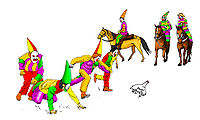 A traditional Courir de Mardi Gras (Mardi Gras run) chases a chicken for use in a communal gumbo.
A traditional Courir de Mardi Gras (Mardi Gras run) chases a chicken for use in a communal gumbo.
In parts of Cajun country, such as Eunice, Basile, Church Point and Mamou, the traditional Courir de Mardi Gras (French for the "Mardi Gras Run") is still held. Le Capitaine leads masked men on horseback to gather ingredients for making the communal meal (usually a gumbo). Participants gather in costume and move from home to home requesting ingredients for the night's meal. This rural Mardi Gras draws on traditions that are centuries old. Revelers sing "La Chanson de Mardi Gras", a song echoing medieval melodies.
People escape from ordinary life partly through the alcohol many consume in their festive quest, but more so through the roles they portray in costume. As they act out their parts in a wild, gaudy pageant, they are escaping from routine existence, freed from the restraints that confine them every other day of the year.[36] The capitaine maintains control over the Mardi Gras. He issues instructions to the riders as they assemble early in the morning and then leads them on their run. When they arrive at a farm house, he obtains permission to enter private property, after which the riders may charge toward the house, where they sing, dance, and beg until the owner offers them an ingredient for a gumbo. Often, the owner will throw a live chicken into the air that the maskers will chase, like football players trying to recover a fumble. By mid to late afternoon, the courir returns to town and parades down the main street on the way to the location where the evening gumbo will be prepared.[36]
Other Louisiana cities
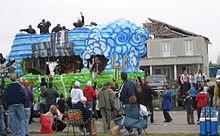 The "Knights of Nemesis" parade rolled through Chalmette in 2006 despite the devastation of Hurricane Katrina.
The "Knights of Nemesis" parade rolled through Chalmette in 2006 despite the devastation of Hurricane Katrina.
Other Louisiana cities holding Mardi Gras parades include Bogalusa, Chalmette, Columbia, Covington, Gretna, Kaplan, La Place, Mandeville, Minden, Monroe, Natchitoches, Slidell, Springhill, and Thibodaux.
Because of violent activities of the American terrorist group, the Ku Klux Klan, Louisiana has a state law prohibiting the wearing of hoods and masks in public. Mardi Gras is one of the occasions when exceptions are allowed, as are Halloween celebrations and religious observance.[37]
Michigan
Detroit
Michigan's first Catholic settlers were French. The Fat Tuesday celebrations of modern times in Detroit stem from the more recent influence of the Polish Paczki Day.
Mississippi
Gulf Coast
Biloxi, Mississippi holds a traditional morning parade by the Gulf Coast Carnival Association (GCCA) and an afternoon parade by the Krewe of Neptune. Nearby Gulfport, holds a traditional night parade sponsored by the Krewe of Gemini. Other parades include evening events in Pascagoula, Ocean Springs, D'Iberville, Gautier, Waveland, Bay St. Louis, Long Beach, and Pass Christian, just to name a few. Damage from Hurricane Katrina led to deviations from traditional routes or parade cancellations in some locations in 2006.
Mardi Gras parades have since become a sign of rebuilding along the coast line. Traditions in Mississippi are closely tied into those of New Orleans, Louisiana. Typically the larger floats which casinos use in the Mississippi parades are rented from float builders in New Orleans. Schools on the Gulf Coast usually let out during the 2-day holiday so children can attend the parades. Much like Mobile and New Orleans, the Mississippi Gulf Coast has its own unique societies and Mardi Gras associations that participate in float building and annual balls. Most of these parades and balls operate along the largest main roads of the coast, Highways 90 and 49. Prior to Katrina, the Biloxi Parade consisted of a morning, noon and night parade. It has since decreased to two parades, GCCA first followed by the Krewe of Neptune.
Central Mississippi
Vicksburg, located along the Mississippi River in central Mississippi, holds an annual Mardi Gras parade,[38] along with a Mardi Gras ball.[39]
Missouri
St. Louis
St. Louis, Missouri claims to have the second largest U.S. Mardi Gras celebration, after New Orleans. Although founded by French settlers in 1764[40] the city doesn't historically have a significant French Catholic population. The St. Louis Mardi Gras was started in the early 1980s by bored, drunk patrons of Hilary's bar in the Soulard neighborhood[41] adjacent to downtown, when they decided to march to another neighboring bar.[41] Over the years, what started as a private party has grown in size and scale, attracted major corporate sponsorship,[41][42] and is a huge part of the tourism economy of St Louis. The event sometimes attracts hundreds of thousands of revelers, with 200,000–250,000 estimated in attendance in 2011.[43] The size of the crowd varies considerably from year to year, with the weather being the biggest factor in determining crowd size. On the second Saturday before Mardi Gras, there is a family-oriented "Krewe of Barkus" pet parade with corporate sponsorship by Beggin' Strips.[42] Participants consist of anyone who dresses up their pet in costume, and walks their pet along the parade route. The parade is followed by the informal Wiener dog races. Then, on the Saturday before Fat Tuesday, the more adult-oriented, flesh-for-beads parade occurs, although there have been various attempts to reserve a family section at one end of the route. People from all over storm the streets with beers and bead necklaces after the Saturday parade. The streets of Soulard, Geyer, Allen, Russell, Ann, Shenandoah, and others are crowded with people from 7th to 12th Street. The Fat Tuesday parade occurs in the evening. In recent years it has been moved from just north of Soulard to downtown St. Louis. The majority of the overall Mardi Gras festivities have corporate sponsorship, primarily from Anheuser-Busch and Southern Comfort.[42] In 2006, this led to an investigation by the Alcohol and Tobacco Tax and Trade Bureau and the Missouri Division of Alcohol and Tobacco Control into the legality of Mardi Gras Inc.'s sponsorship deals.[42]
Oklahoma
Tulsa
In 2010, Tulsa began holding an annual Mardi Gras parade through its downtown Blue Dome District.[44]
Pennsylvania
Philadelphia
There is an unofficial celebration of Mardi Gras on South Street every year. There is a noticeable police presence because of widespread drunkenness and looting that occurred among some of the younger participants in 2001. Local restaurants include New Orleans' themes, such as Fat Tuesday's, Les Bon Temps, and Nola's.
Texas
Galveston
Galveston, Texas is home to the largest Mardi Gras festival in Texas attracting up to 200,000 revelers to the island each year. The celebration in Galveston dates back 1867 when it consisted of merely a masked ball and a theatre performance of Shakespear's "King Henery IV." The emergence of rival Krewes the "Knights of Momus" and the "Knights of Myth" created the first extravagant Mardi Gras celebration in 1871.[45] The island tradition now includes many night parades, masked balls and exquisite costumes. The current Mardi Gras was revived in 1985 by George Mitchell; unlike its New Orleans counterparts, there are no celebrations held on the Monday prior to Fat Tuesday. Since 1987, the Galveston Park Board has managed the event despite its struggles and successes.[46][47][48] Prior to Hurricane Ike, promoters from the Galveston Park Board usually charge admission fees on the first weekend during the Mardi Gras season kickoff. Around 2007, the Park Board slashed $800,000 in their budget due to budget deficits where they decided to drop the admission fee for the 2008 season along with live music performances.[49] After Ike's devastation on Galveston Island, there was no admission charge in 2009 and 2010.[50] An editorial by the Galveston County Daily News in 2007 suggested that Mardi Gras should be managed and operated like Dickens on the Strand as a manageable event under a nonprofit like the Galveston Historical Foundation similar to the Port Arthur, TX Mardi Gras (produced by Mardi Gras of Southeast Texas, Inc).[51] Around April 2010, Galveston businessman Mike Dean, who runs Yaga's Entertainment, Inc. (the producer of the annual Galveston Food and Wine Festival and Chili Quest Festival), entered into a bidding process to become the new Mardi Gras promoter from 2011 – 2015 under a five-year contract, made official on November 18, 2010 as voted on by members of the Galveston City Council.[52] The admission fee has returned – which now includes both weekends prior to Fat Tuesday despite the hiring of 30 security officers to augment local law enforcement. Statistics from the Galveston Convention and Visitor's Bureau have stated that with the admission fees for both weekends, crime has dropped 50% and Galveston Police Chief Charles Wiley is backing the admission fee despite opposition from Downtown Galveston businesses on The Strand and Mechanic Street.[53][54][55][56] Revelers and vendors who usually frequent Mardi Gras on Galveston Island have concerns that the admission fee will bring fewer attendees along with financial uncertainty when the Park Board sold admission tickets prior to the 2008 season.[57] The March 5, 2011 Knights of Momus Parade attracted 20,000 revelers within the Strand while the crowd estimate during the entire Mardi Gras season is 250,000. Vendors and Downtown Galveston businesses have reported a drop in their sales despite the promoter bringing more live music, parades, and added security.[58][59]As a downside, Yaga's Entertainment Inc. incorporated the rules and regulations modeled on Mardi Gras DFW – including a prohibition on professional video and still camera equipment within the Strand Entertainment District.[60][61]
Port Arthur
Port Arthur began celebrating Mardi Gras in 1993.[62]
Dallas
Dallas, Texas is home to a Mardi Gras celebration, MystiQal.[63]
Wisconsin
La Crosse
La Crosse has held a Mardi Gras celebration since 1991. Originally the celebration and its fund-raising efforts were used to provide assistance for Catholic school tuition within the Coulee Catholic Schools system. Now, in addition to the Coulee Catholic Schools, the event provides funding to the Boy Scouts of America, Girl Scouts of the USA, the Boys & Girls Clubs, and the YMCA. The La Crosse Mardi Gras includes a formal costume ball and a family and community festival.[64]
See also
Notes
- ^ a b c d e "New Orleans & Mardi Gras History Timeline" (event list), Mardi Gras Digest, 2005, webpage: MG-time.
- ^ enlou
- ^ a b "Timeline 18th century:" (events), Timelines of History, 2007, webpage: TLine-1700-1724: on "1702–1711" of Mobile.
- ^ "Mardi Gras in Mobile" (history), Jeff Sessions, Senator, Library of Congress, 2006, webpage: LibCongress-2665.
- ^ "Mardi Gras" (history), Mobile Bay Convention & Visitors Bureau, 2007, webpage: MGmobile.
- ^ a b c d e f g "Mardi Gras Terminology". "Mobile Bay Convention & Visitors Bureau". http://www.mobile.org/vis_mardigras_terms.php. Retrieved November 18, 2007.
- ^ Houston, Susan (February 4, 2007). "Mobile; It Has History". The News & Observer (News & Observer Publishing Company, (Raleigh, NC)).
- ^ a b c d e "Mobile Mardi Gras Timeline". "The Museum of Mobile". http://www.museumofmobile.com/html/mardi_gras_timeline.php. Retrieved November 14, 2007.
- ^ "The History of Mardi Gras in New Orleans". "GRB Enterprises". 2006. http://www.mardigrasunmasked.com/mardigras/history.htm. Retrieved January 10, 2008.
- ^ a b c d e f g h i j k "History". "Mobile Carnival Museum". Archived from the original on October 10, 2007. http://web.archive.org/web/20071010041322/http://www.mobilecarnivalmuseum.com/History.aspx. Retrieved November 17, 2007.
- ^ a b "Mardi Gras – Mobile's Paradoxical Party". "The Wisdom of Chief Slacabamorinico". http://jacksonsnyder.com/arc/slac/MardiGras/paradox.htm. Retrieved November 18, 2007.
- ^ "History – Mobile Area Chamber of Commerce". about New Orleans Cowbellions. 2006. http://www.mobilechamber.com/history.asp.
- ^ Arthur B. LaCour, New Orleans Masquerade: Chronicles of Carnival (Pelican Publishing 1952)
- ^ "Joe Cain Articles" (newspaper story), Joe Danborn & Cammie East, Mobile Register, 2001, webpage: CMW-history.
- ^ "Bourbon Street in San Diego", The San Diego Union-Tribune, February 7, 2005 [1].
- ^ 1 Pensacola Carnival Association 1902 program – http://purl.fcla.edu/fcla/dl/WF00000042.pdf
- ^ 1 Pensacola Carnival Association 1902 program – http://purl.fcla.edu/fcla/dl/WF00000042.pdf
- ^ "Unmasking 1st Mardi Gras - chicagotribune.com". Chicago Tribune. http://www.chicagotribune.com/news/nationworld/chi-mardi_gras_slider_bdfeb03,1,5480199.story.
- ^ a b Sparks, R. “American Sodom: New Orleans Faces Its Critics and an Uncertain Future”. La Louisiane à la dérive. The École des Hautes Études en Sciences Sociales Coloquio – December 16, 2005.
- ^ Three centuries of Mardi Gras history. From: carnaval.com. Retrieved October 19, 2007.
- ^ Deja Krewe. The Times-Picayune. Retrieved October 19, 2007.
- ^ "Mardi Gras". http://pages.cs.wisc.edu/~jmeaux/mardi_gras.html.
- ^ "Tulane University-Faces of Mardi Gras". http://tulane.edu/news/newwave/022009_carnival_traditions.cfm.
- ^ "LCVC-LafayetteConvention and Visitiors Commission and". http://www.lafayettetravel.com/travelprofessionals/touritineraries/mardigras/.
- ^ "Lafayette-The Facts". http://www.thebuyersrealty.net/lafayette_the_facts.htm.
- ^ "Mardi Gras – Mardi Gras and The Rio de Janeiro Carnival, Locations, Mardi Gras in popular culture". http://encyclopedia.stateuniversity.com/pages/14314/Mardi-Gras.html. Retrieved January 16, 2010.
- ^ "Tulane University-Faces of Mardi Gras". http://tulane.edu/news/newwave/022009_carnival_traditions.cfm. Retrieved January 16, 2010.
- ^ http://www.louisianacajun.com/Mardi-Gras-Parade-Times-And-Routes/Lake-Charles/
- ^ http://www.swlamardigras.com/
- ^ http://www.fortpolkguardian.com/entertainment/x664190778/Mardi-Gras-in-Lake-Charles-offers-activities-for-adults-children
- ^ http://www.swlamardigras.com/about/history.cfm
- ^ http://www.louisianacajun.com/2009-Mardi-Gras/Lake-Charles-Parade-Schedules/Krewe-of-Krewes-Parade---Mardi-Gras-Southwest-Louisiana/143
- ^ http://www.buses.org/files/Top100-10_Layout_1.pdf
- ^ http://www.swlamardigras.com/year-round/mardi-gras-museum.cfm
- ^ http://www.swlamardigras.com/about/did-you-know.cfm
- ^ a b www.lsue.edu "Mardi Gras in Rural Acadiana", Louisiana State University
- ^ [2]
- ^ City of Vicksburg
- ^ PR Log
- ^ Hoffhaus. (1984). Chez Les Canses: Three Centuries at Kawsmouth. Kansas City: Lowell Press. ISBN 0-913504-91-2
- ^ a b c "St. Louis Mardi Gras Parties and Celebrations". http://www.stlouis.com/mardi-gras/. Retrieved February 17, 2010.
- ^ a b c d "Party Nazis-Has Mardi Gras become a tool of mega-buck sponsors? That's what state and federal authorities are asking". http://www.riverfronttimes.com/content/printVersion/150065. Retrieved February 10, 2010.
- ^ "St. Louis Mardi Gras Attendance". http://www.fox2now.com/news/ktvi-mardi-gras-cleanup-030611,0,7081272.story.
- ^ Jason Ashley Wright, "Mardi Gras parade to feature iconic dress", Tulsa World, March 8, 2011.
- ^ http://www.galveston.com/mardigras/
- ^ http://www.chron.com/default/article/Bigger-crowds-expected-as-Isle-Mardi-Gras-starts-1607555.php
- ^ http://galvestondailynews.com/story/68167/
- ^ http://galvestondailynews.com/story/67852/
- ^ http://www.chron.com/default/article/Galveston-axes-live-musical-acts-from-Mardi-Gras-1629838.php
- ^ http://www.chron.com/default/article/Galveston-debuts-revamped-Mardi-Gras-1774554.php
- ^ http://galvestondailynews.com/story/107092/
- ^ http://www.galveston.com/city111810a/
- ^ http://www.chron.com/default/article/Mardi-Gras-arrests-down-50-in-Galveston-1682277.php
- ^ http://www.chron.com/news/houston-texas/article/Bigger-Galveston-Mardi-Gras-coming-at-a-cost-for-1685643.php
- ^ http://galvestondailynews.com/story/209726
- ^ http://www.chron.com/disp/story.mpl/metropolitan/7445219.html
- ^ http://galvestondailynews.com/story/82412
- ^ http://www.khou.com/news/local/Some-attendees-not-happy-with-Mardi-Gras-Galveston-prices-117487083.html
- ^ http://abclocal.go.com/ktrk/story?section=news/local&id=7988446
- ^ http://www.mardigrasdfw.com/generalinfo.html#items
- ^ http://www.mardigrasgalveston.com/general/faq.asp#Please_do_not_bring_the_following_items
- ^ Portarthur.com History of the Mardi Gras celebration, Port Arthur Website
- ^ "MystiQal Mardi Gras Nighttime Parade". February 2, 2008. http://www.pegasusnews.com/events/2008/feb/02/78948/. Retrieved February 12, 2010.
- ^ La Crosse Mardi Gras
External links
- Mardi Gras – Myth & History
- Traditional Cajun Mardi Gras Celebrations
- Mardi Gras in Mobile, Encyclopedia of Alabama
Categories:- Mardi Gras
- Carnival of the United States
Wikimedia Foundation. 2010.

